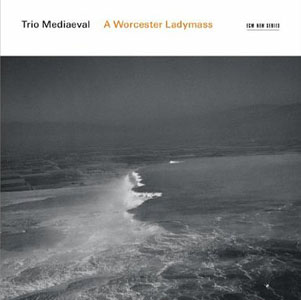I think one reason I’m so fond of Trio Mediaeval is that their attitude toward the performance of early music mirrors my own: in their introduction to this disc, they note that performing music from a thousand years ago (give or take a century or two) necessarily involves as much recreation as interpretation, since any contemporary rendering is filtered through contemporary sensibilities.
 The Worcester Ladymass performed here is derived from manuscripts — or pieces of them — known as the “Worcester Fragments.” This name is perhaps more easily understood when one remembers that most of the English music we have from this period comes from scraps, manuscripts that were cut up to be used as binding material for other manuscripts. The performers (who are as much scholars as singers, by necessity) note that Worcester is a rich source of polyphony from the early thirteenth century to the early fourteenth — enough for three large anthologies. This presentation is termed a “Ladymass” because such masses were common; in this case, much of the music was specifically associated with the Feast of the Assumption, celebrated on August 15. This is particularly relevant to Worcester, since the cathedral was dedicated to Our Lady. The stages of the mass, with the exception of the “Credo” and the “Benedicamus Domino,” were drawn entirely from the Worcester Fragments, although not all were necessarily part of a particular mass. The latter two settings were created by English composer Gavin Bryars for this recording.
The Worcester Ladymass performed here is derived from manuscripts — or pieces of them — known as the “Worcester Fragments.” This name is perhaps more easily understood when one remembers that most of the English music we have from this period comes from scraps, manuscripts that were cut up to be used as binding material for other manuscripts. The performers (who are as much scholars as singers, by necessity) note that Worcester is a rich source of polyphony from the early thirteenth century to the early fourteenth — enough for three large anthologies. This presentation is termed a “Ladymass” because such masses were common; in this case, much of the music was specifically associated with the Feast of the Assumption, celebrated on August 15. This is particularly relevant to Worcester, since the cathedral was dedicated to Our Lady. The stages of the mass, with the exception of the “Credo” and the “Benedicamus Domino,” were drawn entirely from the Worcester Fragments, although not all were necessarily part of a particular mass. The latter two settings were created by English composer Gavin Bryars for this recording.
Listening to this recording, it’s something of a jolt to be reminded that this music was originally sung by monks, not nuns: the voices are so perfectly suited to the music that it’s hard to imagine any other sound. The three singers — Anna Maria Friman, Linn Andrea Fuglseth, and Torunn Østrem Ossum — bring not only intelligence and sensitivity to their performance, but an ethereal quality that brings home the spirituality of the music.
It is perhaps emblematic of the intelligence and conceptual unity in this recording that Bryars’ contributions fit seamlessly into the mass. If one listens very carefully to the “Credo” one gets hints that this is not from the thirteenth century, but one must listen very carefully. The “Bendicamus Domini,” on the other hand, is indistinguishable from the thirteenth-century “Alma Dei Genetrix” that immediately precedes it.
There are very few artists making credible recordings of early European sacred music, and Trio Mediaeval shares top honors with one, maybe two others. And in this recording, especially, they’ve brought a deep sense of the spirit of the mass to a contemporary audience.
(ECM New Series, 2011)
